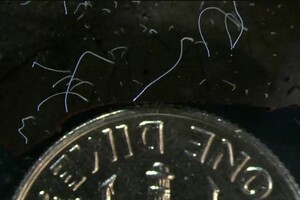It is about 50 times larger than all known so far.

Scientists have discovered in Guadeloupe the largest known at present moment of bacteria. It looks like a white thread the length of a human eyelash, according to The Guardian.
The bacterium Thiomargarita magnifica is one centimeter long, about 50 times larger than all other known giant bacteria, and the first to be seen unarmed. eye. Thin white filaments have been found on the surface of mangrove leaves in shallow tropical marine swamps.
Read also: Scientists have discovered a new mechanism of bacterial infection of cells
The discovery came as a surprise to scientists as a model of cellular metabolism suggest that bacteria cannot grow to such sizes. It was assumed that the upper limit of the possible size is about 100 times smaller than that of the detected species.
“If you look at it in context, it would be like meeting a person with another person as tall as Mount Everest,” said study co-author Jean-Marie Wolland, a scientist at Lawrence National Laboratory in Berkeley.
The body was discovered by Olivier Gro, professor of marine biology at the Antilles University of Guadeloupe. He searched for symbiotic bacteria in the mangrove shrub ecosystem.
Gro admits that he was surprised to see the body. The researchers first analyzed in the lab to determine that the filaments were indeed unicellular. On closer inspection, they found a strange internal structure. In most bacteria, DNA floats freely inside the cell, while Thiomargarita magnifica keeps it more organized, inside membrane-bound components located throughout the cell.
It has also been found that the body contains three times more genes than most bacteria, and hundreds of thousands of copies of the genome are scattered across each cell, making it extremely complex.
So far, scientists can't say for sure how the bacterium to become so great. One version is that this evolutionary advantage helps protect against predators. “If you become hundreds of times bigger than a predator, it will not be able to absorb you,” Woland said.
But as it grows so large, the bacterium loses some bacterial benefits, including the ability to move and colonize new niches. “Leaving the microscopic world, these bacteria have definitely changed the way they interact with the environment,” Wolland added.
So far, a new species of bacteria has not been found elsewhere. Moreover, scientists have not been able to find them in the original place again, possibly because they are seasonal organisms. However, scientists suggest that larger and more complex bacteria may be hiding in front of everyone.
Earlier, scientists announced the discovery of a strain of gonorrhea in Europe with broad drug resistance . This is the second such strain found in recent years.




